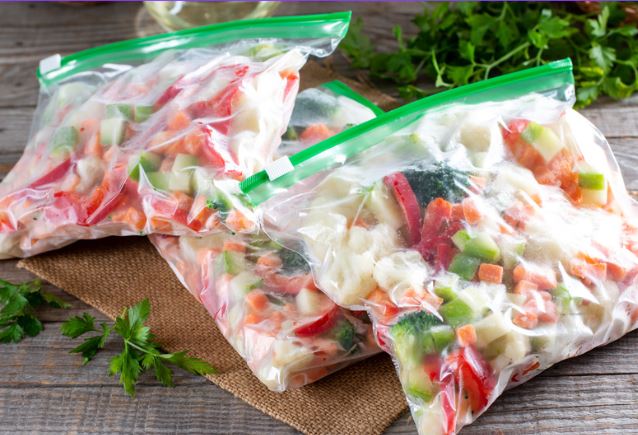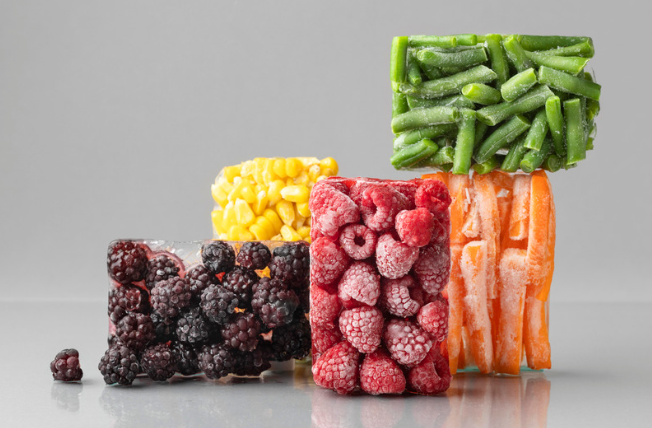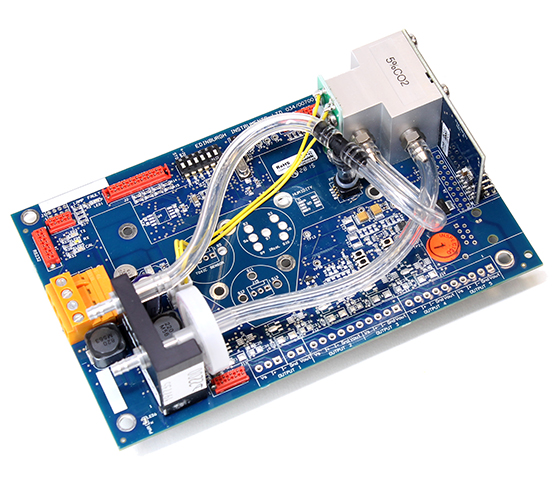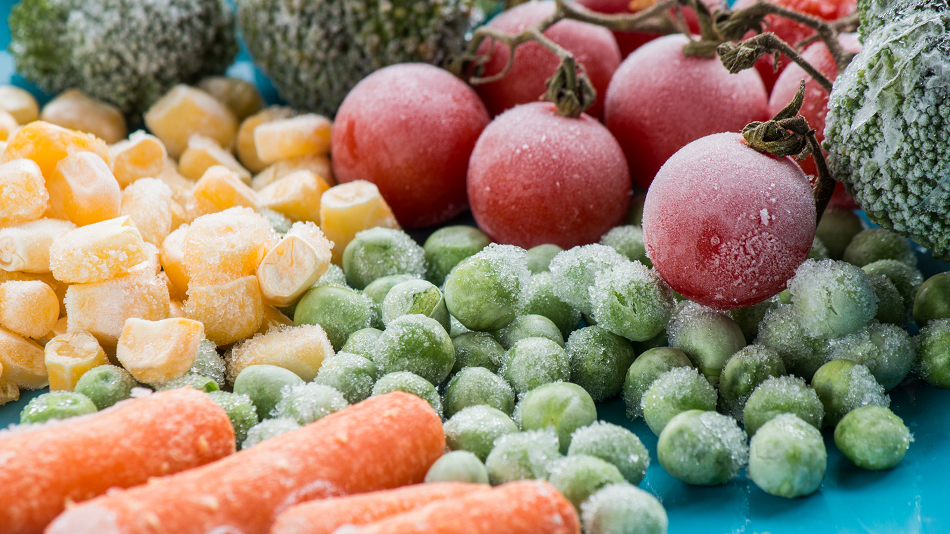Frozen food storage helps prevent food spoilage and retains your foods nutritious value. For dried and frozen food storage, real-time gas monitoring and logging can help prevent unnecessary wastage while keeping produce in its optimal conditions. To achieve this requires gas detectors capable of constant, online analysis and with rapid response times and good accuracy. In this article we will explore how modified atmospheres, dried and frozen food storage and Edinburgh Sensors gas detection systems for frozen food storage.
There are many different approaches to food preservation for extending the lifetimes of perishable goods. From pickling, salting, canning or jellying, all of these approaches have different effects on the properties of the preserved produce and are suitable for different types of food. Two of the most widely used methods for food preservation are dried and frozen food storage.
The low temperatures involved in freezing food kill and prevent the growth of bacteria and other microorganisms and help to reduce nutrient loss.1 Drying foods, on the other hand, achieve bacterial growth inhibition by removing moisture from the food and slows down the enzyme activity alongside this.2
As well as the atmospheric conditions during the freezing or drying process being important for maximizing the quality of the produce, the relative ratios of different atmospheric gases and humidity is also crucial during the storage of preserved foods. For dried products such as flour or cereals, ‘modified atmospheric conditions’, or storage of the food in specific, controlled mixture of gases, can extend shelf life by up to three times by inhibiting chemical reactions that lead to degradation and spoilage.3

Modified Atmospheres
Modified atmospheric conditions are now commonplace in the packaging, storage, and transport of all kinds of food products, from fresh to frozen produce.4 High carbon dioxide and reduced oxygen levels can be beneficial for killing invasive insect species of microorganisms that would otherwise grow on and spoil the food as it was stored. 5 High nitrogen concentrations can be used as a humidity control for keeping dried foods as it can help preserve food quality while extending food lifetimes.6
By using gas mixtures to replace insecticides and the addition of preservatives such as nitrites to meats, modified atmospheric package, and controlled atmosphere storage offer a versatile and effective way to preserve foods without the need to add additional chemicals or processing stages.7
The main gases of interest for modified atmosphere storage are carbon dioxide, oxygen, and nitrogen. However, controlling and maintaining the concentrations of these gases, particularly for dried food storage can be challenging. Optimum conditions often require very precise levels of control, with gas concentration ranges needing to be within 1 % of a given value. The other challenge for foods such as cereals is that they continue to produce and release gases such as carbon dioxide and carbon monoxide8 so the atmospheric conditions require constant adjustment. Monitoring gas levels is advantageous not just for maintaining optimum storage conditions, but also as increased carbon dioxide production can be an early indicator of food spoilage.9
Dried and Frozen Food Storage

Gas monitoring for dried and frozen food storage comes with a particular set of challenges. Often, the freezing process is performed using carbon dioxide as a cryogen. The carbon dioxide is normally used in its solid form, known as ‘dry ice’, which has a temperature of – 79◦C. This allows rapid cooling of the food to help reduce risk of contamination and preserve food quality.
However, the National Institute for Occupational Health and Safety indicating that CO2 levels of 40 000 ppm (4%) are immediately dangerous to life and health10 with 10-hour workplace exposure limits being set at much lower limits.11 Foods may also be kept in similar cryogenic conditions during transportation and before use to reduce food wastage so reliable gas monitoring during the freezing and storage process is an essential part of health and safety.
For dried foods, even dried fruits produce not insignificant levels of carbon dioxide over time12 so for storage of large volumes of dried fruits, such as in grain barges, carbon dioxide monitoring is key for both food preservation and worker safety.
Gas Detection for Dried and Frozen Food Storage
For dried and frozen food storage, real-time gas monitoring and logging can help prevent unnecessary wastage while keeping produce in its optimal conditions. To achieve this requires gas detectors capable of constant, online analysis and with rapid response times and good accuracy.
Edinburgh Sensors are one of the market leaders in the development and production of non-dispersive infrared sensors (NDIR). As many hydrocarbon gases and molecules like carbon dioxide absorb infrared light very efficiently, NDIR sensors offer a very sensitive approach to detecting even small concentrations of such molecules.

Gascard NG from Edinburgh Sensors
Some of the NDIR sensors offered by Edinburgh Sensors include the Gascard NG13, the Guardian NG 14, and the Gascheck.15 All of these devices have minimal need for re-calibration and long device lifetimes and are capable of self-correcting measurements over a range of humidity conditions (0 – 95 %) ensuring they always achieve the best accuracy and reliability.
All of Edinburgh Sensors’s products can be interfaced with networking data logging systems or more complex control software if setting up feedback systems to maintain active control over modified atmospheric conditions is desirable. In the case of the Gascard, this can be done with on-board R323 connections but the Boxed Gascard16 version of this instrument can also be quickly connected via USB for immediate use.
With accuracies for carbon dioxide monitoring typically in the ± 2 % range, Edinburgh Sensors has a variety of solutions for gas monitoring even in challenging environmental conditions and offer full pre- and post-purchase technical sales advice.
Stay in Touch
We hope you have enjoyed this article on frozen food storage and how real-time gas monitoring and logging can help stop prevent food wastage. To find out how we can help you with your gas monitoring solutions for your dried and frozen food storage, simply contact us.
Keep up to date with out latest articles and product news by signing up for our monthly newsletter via the sign up button below. Find us on Twitter, Facebook, and Linkedin.
References
- Rickman, J. C. et al., Nutritional comparison of fresh, frozen and canned fruits and vegetables. (2007). Part 1. Vitamins C and B and phenolic compounds, Sci. Food Agric., 87, 930–944.
- Sagar, V. R. and Suresh Kumar, P., Recent advances in drying and dehydration of fruits and vegetables: A review, (2010). Food Sci. Technol., 47, 15–26.
- Dried Food Storage (2019)
- Correct Gas Concentrations for Atmospheric Packaging, (2018)
- Suleiman, R. et al. (2013). Effects of Deterioration Parameters on Storage of Maize, Nat. Sci. Res., 3, 147–165.
- Jayas, D. S. and Jeyamkondan S. (2002). Modified atmosphere storage of grains meats fruits and vegetables, Eng., 82, 235–251.
- Hussein, Z., et al,, (2015). Perforation-mediated modified atmosphere packaging of fresh and minimally processed produce-A review, Food Packag. Shelf Life, 6, 7–20.
- Reuss, R. and Pratt, S., (2001). Accumulation of carbon monoxide and carbon dioxide in stored canola, Stored Prod. Res., 37, 23–34.
- Maier, D. E. et al. (2006). Monitoring carbon dioxide levels for early detection of spoilage and pests in stored grain. Proceedings of the 9th International Working Conference on Stored Product Protection PS10-6160.
- NIOSH Guidelines, (2019)
- HSE on CO2, (accessed 2019)
- Miranda, G. et al., (2019) Dried-Fruit Storage: An Analysis of Package Headspace Atmosphere Changes, Foods, 8, 56.
- Gascard NG, (2019)
- Guardian NG (2019)
- Gascheck (2019)
- Boxed GasCard (2019)
- Shiferaw, B. et al. (2019). Crops that feed the world 10. Past successes and future challenges to the role played by wheat in global food security. Food Secur., 2013, 5, 291–317.
- Suleiman, R. et al. (2013). Effects of Deterioration Parameters on Storage of Maize, Nat. Sci. Res., 3, 147–165.
- Tuite, J., and Foster, G. H. (1979). Control of storage diseases of grain. Annual Review of Phytopathology, 17(1), 343-366.
- Navarro, S., and Navarro, H. (2016). Emerging Global Technological Challenges in the Reduction of Postharvest Grain Losses. Proceedings of the 15th International Cereal and Bread Congress, 39.
- Correct Gas Concentrations for Atmospheric Packaging, (2018)
- Pekmez, H. (2017). Cereal Storage Techniques: A Review, Agric. Sci. Technol. B, 6, 1–6.
- Reuss, R. and Pratt, S., (2001). Accumulation of carbon monoxide and carbon dioxide in stored canola, Stored Prod. Res., 37, 23–34.
- Maier, D. E. et al. (2006). Monitoring carbon dioxide levels for early detection of spoilage and pests in stored grain. Proceedings of the 9th International Working Conference on Stored Product Protection PS10-6160.
- Gascard NG, (2019)
- Guardian NG (2019)
- Gascheck (2019)
- Boxed GasCard (2019)

